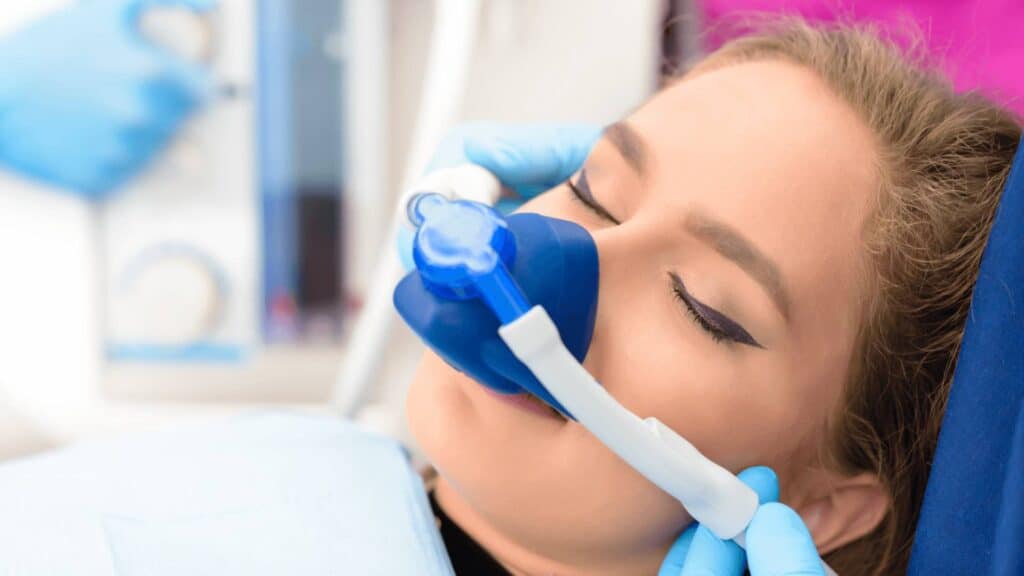Nitrous Sedation
Comfortable Dental Office

Nitrous oxide (N2O) is the most used inhalation anesthetic in dental offices, emergency rooms, and outpatient surgery centers. When administered by itself, it cannot reliably provide general anesthesia. However, it has an exceptional safety profile and is a great option for delivering little to moderate sedation for anxious patients undergoing modest oral surgical procedures. This article has covered the advantages and disadvantages of using N2O during minor oral surgery to lessen patient discomfort and anxiety.
What is Nitrous Oxide?
Nitrous oxide is a gas that is almost colorless and odorless, with a faint, pleasant scent. It is a strong analgesic and anti-anxiety substance that has little to no effect on breathing and helps calms the central nervous system.
Nitrous Oxide in Oral Surgery
Patient anxiety has long been a major issue in dentistry practices. Dentists are adept at assisting patients in coping with their discomfort and worry. Although psychological techniques can be utilized to lessen pain and anxiety, many times pharmacological techniques are required. Analgesia/anxiolysis may hasten the completion of operations for kids that aren’t very painful but require the youngster to stay motionless. It may also make unpleasant surgeries easier for the patient to handle by reducing or soothing pain, discomfort, or anxiety. The outcomes of pharmacological techniques depend on how each patient responds to various drugs. However, the clinical outcome of nitrous oxide/oxygen inhalation is more predictable for the great majority of persons.
Preinstructions
The patient should be told not to eat a substantial meal before using N2O therapy. Patients should avoid wearing contact lenses since gas leaks at the nose’s bridge can result in dry eyes.
Techniques of Administration
At the beginning and end of a nitrous oxide-oxygen sedation, the patient will always get 100% oxygen. After that, gently start to breathe. The majority of patients can typically tolerate a flow rate of 5–6 L/min. The flow rate can be altered after watching the reservoir bag. The bag should gently pulse with each breath; it shouldn’t be overly or underinflated. After delivering 100% oxygen for a period of 1-2 minutes, it is advisable to titrate N2O at intervals of 10%. While nitrous oxide/oxygen analgesia/anxiolysis is being used, the concentration of N2O shouldn’t normally increase above 50%. As soon as the desired outcome is achieved, the N2O concentration is increased. It is crucial to remind the patient to breathe through their nose numerous times for the gas to work.
The patient should be questioned about their feelings to ensure that the proper dosage of nitrous oxide is administered. Each patient will react to treatment in a unique way. If the nitrous level being administered is too low, the patient won’t receive an effective dosage of anxiolytics. A too-high nitrous level could have undesirable side effects.
According to research, children desaturate more quickly than teenagers, thus it’s critical to provide the patient 100% oxygen for 3 to 5 minutes after the nitrous oxide in a closed system has been stopped.
The objectives of nitrous oxide/oxygen inhalation include
- Reduce or eliminate anxiety
- Improve patient cooperation and communication
- Reduce unfavorable movement and reaction to dental treatment
- Raise the pain response threshold
- Increase your tolerance for lengthy appointments
- Aid in the care of a patient who is physically, mentally, or medically vulnerable.
- Reduce gag reflex and improve sedative effects of medicines.
Indications
- A frightened, apprehensive, or uncooperative patient
- A few people with unique healthcare requirements
- A person whose gag reflex makes it difficult to provide dental care
- A patient who cannot receive significant local anesthesia
- A young patient is undergoing a drawn-out dental procedure.
Contraindications
- Pulmoary illness that result in persistent blockage
- Extremely unstable emotional states or drug use
- Pregnancy in its early stages
- Using bleomycin sulfate as a treatment
- A deficiency in the methylenetetrahydrofolate reductase enzyme
When feasible, relevant medical specialists should be consulted before administering analgesic/anxiolytic medications to people with serious underlying medical conditions (e.g. severe obstructive pulmonary disease, congestive heart failure, sickle cell disease, acute otitis media, recent tympanic membrane graft, acute severe head injury).
Advantages
- Easy to understand and use
- Swift movement starts.
- N2O has a neutral, pleasant, and non-irritating odor.
- There is no hangover effect since N2O is immediately absorbed and ejected.
- Quick recovery
- Titrating is a possibility.
- A substantial safety margin exists.
- There is cardio-respiratory stability.
- It is uncommon to feel queasy or vomit.
- Flexibility is maintained.
- No patient preparation is required.
- Escorts are not necessary.

